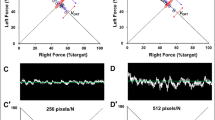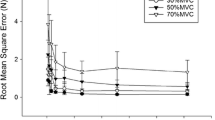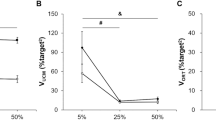Abstract
This study examined the question of whether and how the influence of visual information on force coordination patterns is dependent on the settings of a task asymmetry constraint. In a bimanual isometric force experiment, the task asymmetry was manipulated via imposing different coefficients on the index finger forces such that the weighted sum of the finger forces matched the target force. The environmental constraint was quantified by the visual performance error and was manipulated through the change of visual gain (number of pixels on the screen representing the unit of force). The constraint arising from the individual was quantified by the bilateral coupling effect (i.e., symmetric force production) between hands. The results revealed improved performance in terms of lower variability and performance error and more complex total force structure with higher visual gain. The influence of visual gain on the force coordination pattern, however, was found to be dependent on the task coefficients imposed on the finger forces. Namely, the force sharing between hands became more symmetric with high visual gain only when the right finger force had the higher coefficient, and an error-compensatory strategy was evident with high gain only when symmetric coefficients were imposed on the two fingers. The findings support the proposition that the motor coordination and control patterns are organized by the interactive influence of different categories of constraints where the functional influence of the information provided is dependent on the motor output.




Similar content being viewed by others
References
Baweja HS, Patel BK, Martinkewiz JD, Vu J, Christou EA (2009) Removal of visual feedback alters muscle activity and reduces force variability during constant isometric contractions. Exp Brain Res 197:35–47
Baweja HS, Kennedy DM, Vu J, Vaillancourt DE, Christou EA (2010) Greater amount of visual feedback decreases force variability by reducing force oscillations from 0–1 and 3–7 Hz. Eur J Appl Physiol 108:935–943
Block HJ, Bastian AJ (2010) Sensory reweighting in targeted reaching: effects of conscious effort, error history, and target salience. J Neurophysiol 103:206–217
Christou EA (2005) Visual feedback attenuates force fluctuations induced by a stressor. Med Sci Sports Exerc 37:2126–2133
Cole JD, Sedgwick EM (1992) The perceptions of force and of movement in a man without large myelinated sensory afferents below the neck. J Physiol (Lond) 449:503–515
Coombes SA, Corcos DM, Sprute L, Vaillancourt DE (2010) Selective regions of the visuomotor system are related to gain-induced changes in force error. J Neurophysiol 103:2114–2123
Davids K, Button C, Bennett S (2007) Dynamics of skill acquisition: a constraints-led approach. Human Kinetics, Champaign
Ernst MO, Banks MS (2002) Humans integrate visual and haptic information in a statistically optimal fashion. Nature 415:429–433
Gandevia SC, Macefield G, Burke D, McKenzie DK (1990) Voluntary activation of human motor axons in the absence of muscle afferent feedback. The control of the deafferented hand. Brain 113(Pt 5):1563–1581
Ganesh G, Haruno M, Kawato M, Burdet E (2010) Motor memory and local minimization of error and effort, not global optimization, determine motor behavior. J Neurophysiol 104:382–390
Goble JA, Zhang Y, Shimansky Y, Sharma S, Dounskaia NV (2007) Directional biases reveal utilization of arm’s biomechanical properties for optimization of motor behavior. J Neurophysiol 98:1240–1252
Hong SL, Brown AJ, Newell KM (2008) Compensatory properties of visual information in the control of isometric force. Percept Psychophys 70:306–313
Hu X, Newell KM (2010) Adaptation to selective visual scaling of short time scale processes in isometric force. Neurosci Lett 469:131–134
Hu X, Newell KM (2011a) Adaptation to bimanual asymmetric weights in isometric force coordination. Neurosci Lett 490:121–125
Hu X, Newell KM (2011b) Modeling constraints to redundancy in bimanual force coordination. J Neurophysiol 105:2169–2180
Hu X, Loncharich M, Newell KM (2011) Visual information interacts with neuromuscular factors in the coordination of bimanual isometric force. Exp Brain Res 209:129–138
Kantowitz BH, Elvers GC (1988) Fitts’ law with an isometric controller: effects of order of control and control-display gain. J Mot Behav 20:53–66
Kelso JA (1995) Dynamic patterns: the self-organization of brain and behavior. MIT Press, Cambridge
Mechsner F, Kerzel D, Knoblich G, Prinz W (2001) Perceptual basis of bimanual coordination. Nature 414:69–73
Miall RC, Weir DJ, Stein JF (1993) Intermittency in human manual tracking tasks. J Mot Behav 25:53–63
Morrison S, Newell KM (1998) Interlimb coordination as a function of isometric force output. J Mot Behav 30:323–342
Nelson WL (1983) Physical principles for economies of skilled movements. Biol Cybern 46:135–147
Newell KM (1986) Constraints on the development of coordination. In: Wade MG, Whiting HTA (eds) Motor development in children: aspects of coordination and control. Martinus Nijhoff, Dordrecht, pp 341–360
Newell KM, MacDonald PV (1994) Information, coordination and the control in a prehensile force task. Hum Mov Sci 13:375–391
Pincus SM (1991) Approximate entropy as a measure of system complexity. Proc Natl Acad Sci USA 88:2297–2301
Prodoehl J, Vaillancourt DE (2010) Effects of visual gain on force control at the elbow and ankle. Exp Brain Res 200:67–79
Ranganathan R, Newell KM (2008a) Motor synergies: feedback and error compensation within and between trials. Exp Brain Res 186:561–570
Ranganathan R, Newell KM (2008b) Online feedback and the regulation of degrees of freedom in motor control. Hum Mov Sci 27:577–589
Renshaw I, Davids K, Savelsbergh G (2010) Motor learning in practice: a constraints-led approach. Routledge, Oxford
Rosenbaum DA, Loukopoulos LD, Meulenbroek RG, Vaughan J, Engelbrecht SE (1995) Planning reaches by evaluating stored postures. Psychol Rev 102:28–67
Rosenbaum DA, Dawson AM, Challis JH (2006) Haptic tracking permits bimanual independence. J Exp Psychol Hum Percept Perform 32:1266–1275
Sainburg RL (2002) Evidence for a dynamic-dominance hypothesis of handedness. Exp Brain Res 142:241–258
Sainburg RL, Wang J (2002) Interlimb transfer of visuomotor rotations: independence of direction and final position information. Exp Brain Res 145:437–447
Schmidt RC, Bienvenu M, Fitzpatrick PA, Amazeen PG (1998) A comparison of intra- and interpersonal interlimb coordination: coordination breakdowns and coupling strength. J Exp Psychol Hum Percept Perform 24:884–900
Sosnoff JJ, Newell KM (2005) Intermittent visual information and the multiple time scales of visual motor control of continuous isometric force production. Percept Psychophys 67:335–344
Sosnoff JJ, Newell KM (2006) Information processing limitations with aging in the visual scaling of isometric force. Exp Brain Res 170:423–432
Sosnoff JJ, Jordan K, Newell KM (2005) Information and force level interact in regulating force output during two and three digit grip configurations. Exp Brain Res 167:76–85
Sosnoff JJ, Valantine AD, Newell KM (2009) The adaptive range of 1/f isometric force production. J Exp Psychol Hum Percept Perform 35:439–446
Swinnen SP, Wenderoth N (2004) Two hands, one brain: cognitive neuroscience of bimanual skill. Trends Cogn Sci 8:18–25
Swinnen SP, Dounskaia N, Levin O, Duysens J (2001) Constraints during bimanual coordination: the role of direction in relation to amplitude and force requirements. Behav Brain Res 123:201–218
Swinnen SP, Li Y, Dounskaia N, Byblow W, Stinear C, Wagemans J (2004) Perception-action coupling during bimanual coordination: the role of visual perception in the coalition of constraints that govern bimanual action. J Mot Behav 36:394–398
Teasdale N, Forget R, Bard C, Paillard J, Fleury M, Lamarre Y (1993) The role of proprioceptive information for the production of isometric forces and for handwriting tasks. Acta Psychol (Amst) 82:179–191
Todorov E, Jordan MI (2002) Optimal feedback control as a theory of motor coordination. Nat Neurosci 5:1226–1235
Tracy BL (2007) Visuomotor contribution to force variability in the plantarflexor and dorsiflexor muscles. Hum Mov Sci 26:796–807
Vaillancourt DE, Russell DM (2002) Temporal capacity of short-term visuomotor memory in continuous force production. Exp Brain Res 145:275–285
van Beers RJ, Baraduc P, Wolpert DM (2002) Role of uncertainty in sensorimotor control. Philos Trans R Soc Lond B Biol Sci 357:1137–1145
Wyke M (1968) The effect of brain lesions in the performance of an arm-hand precision task. Neuropsychologia 6:125–134
Author information
Authors and Affiliations
Corresponding author
Rights and permissions
About this article
Cite this article
Hu, X., Newell, K.M. Visual information gain and task asymmetry interact in bimanual force coordination and control. Exp Brain Res 212, 497–504 (2011). https://doi.org/10.1007/s00221-011-2760-6
Received:
Accepted:
Published:
Issue Date:
DOI: https://doi.org/10.1007/s00221-011-2760-6




